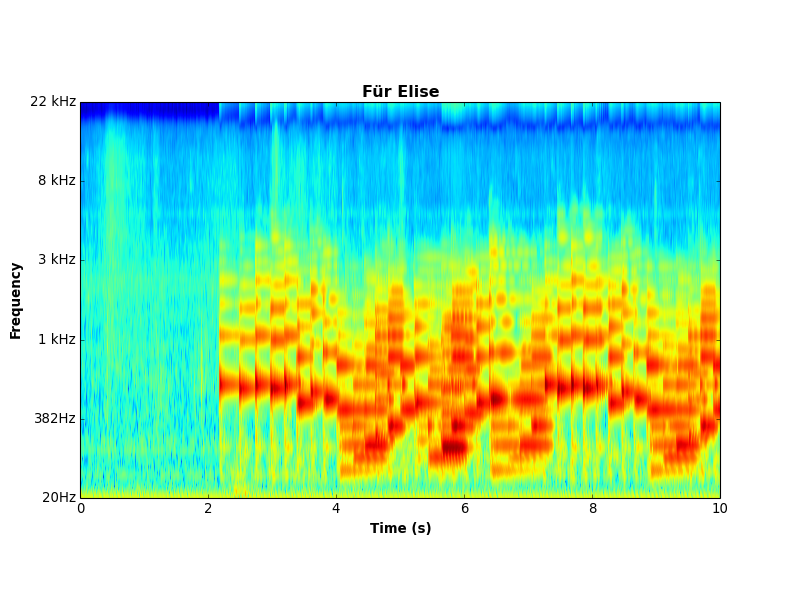Utilities for analysing sound using perceptual models of human hearing.
Jason Heeris, 2013
This is a port of Malcolm Slaney's and Dan Ellis' gammatone filterbank MATLAB code, detailed below, to Python 2 and 3 using Numpy and Scipy. It analyses signals by running them through banks of gammatone filters, similar to Fourier-based spectrogram analysis.
You can install directly from this git repository using:
pip install git+https://github.com/detly/gammatone.git
...or you can clone the git repository however you prefer, and do:
pip install .
...or:
python setup.py install
...from the cloned tree.
- numpy
- scipy
- nose
- mock
- matplotlib
See the API documentation. For a
demonstration, find a .wav file (for example,
Für Elise) and run:
python -m gammatone FurElise.wav -d 10
...to see a gammatone-gram of the first ten seconds of the track. If you've
installed via pip or setup.py install, you should also be able to just run:
gammatone FurElise.wav -d 10
This project is based on research into how humans perceive audio, originally published by Malcolm Slaney:
Slaney's report describes a way of modelling how the human ear perceives, emphasises and separates different frequencies of sound. A series of gammatone filters are constructed whose width increases with increasing centre frequency, and this bank of filters is applied to a time-domain signal. The result of this is a spectrum that should represent the human experience of sound better than, say, a Fourier-domain spectrum would.
A gammatone filter has an impulse response that is a sine wave multiplied by a gamma distribution function. It is a common approach to modelling the auditory system.
The gammatone filterbank approach can be considered analogous (but not equivalent) to a discrete Fourier transform where the frequency axis is logarithmic. For example, a series of notes spaced an octave apart would appear to be roughly linearly spaced; or a sound that was distributed across the same linear frequency range would appear to have more spread at lower frequencies.
The real goal of this toolkit is to allow easy computation of the gammatone equivalent of a spectrogram — a time-varying spectrum of energy over audible frequencies based on a gammatone filterbank.
Slaney demonstrated his research with an initial implementation in MATLAB. This implementation was later extended by Dan Ellis, who found a way to approximate a "gammatone-gram" by using the fast Fourier transform. Ellis' code calculates a matrix of weights that can be applied to the output of a FFT so that a Fourier-based spectrogram can easily be transformed into such an approximation.
Ellis' code and documentation is here: Gammatone-like spectrograms
I became interested in this because of my background in science communication and my general interest in the teaching of signal processing. I find that the spectrogram approach to visualising signals is adequate for illustrating abstract systems or the mathematical properties of transforms, but bears little correspondence to a person's own experience of sound. If someone wants to see what their favourite piece of music "looks like," a normal Fourier transform based spectrogram is actually quite a poor way to visualise it. Features of the audio seem to be oddly spaced or unnaturally emphasised or de-emphasised depending on where they are in the frequency domain.
The gammatone filterbank approach seems to be closer to what someone might intuitively expect a visualisation of sound to look like, and can help develop an intuition about alternative representations of signals.
Since this is a port of existing MATLAB code, I've written tests to verify the Python implementation against the original code. These tests aren't unit tests, but they do generally test single functions. Running the tests has the same workflow:
-
Run the scripts in the
test_generationdirectory. This will create a.matfile containing test data intests/data. -
Run
nosetest3in the top level directory. This will find and run all the tests in thetestsdirectory.
Although I'm usually loathe to check in generated files to version control, I'm
willing to make an exception for the .mat files containing the test data. My
reasoning is that they represent the decoupling of my code from the MATLAB code,
and if the two projects were separated, they would be considered a part of the
Python code, not the original MATLAB code.
